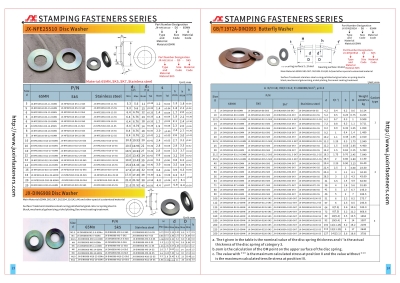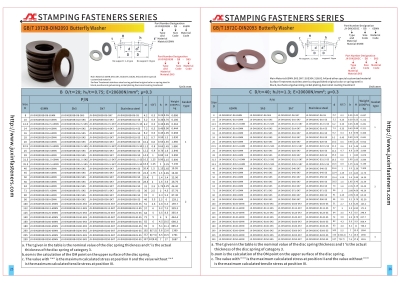Call Us
+86 136 6007 9809
Call Us
+86 136 6007 9809
Oct. 25, 2023
Characteristics of Plate Spring Nuts
Plate spring nut is a particular fastener; the surface should not have cracks, cuts, burrs, rust, and other defects that affect the use. The material is generally 65Mn, 60Si2Mn. The hardness is 400HV-500HV due to its unique structural form, which is different from ordinary nuts, so it has an impressive scope of application and characteristics. The main features of plate spring nuts are as follows:
1. A sizeable locking force for locking parts will not loosen or vibrate when the nut is cracking.
2. Good anti-loosening and anti-vibration abilities can be applied to high-vibration or high-impact occasions.
3. It has good adjustability, which can be used on occasions when the structure size needs to be locked and adjusted. The size can be adjusted only by adjusting the pressure of the leaf spring nut.
4. It is suitable for some structural dimensions that need to be frequently disassembled during use.
Whether the leaf spring nut is a standard part, and what are the materials?
The plate spring nut does not belong to the mechanical class of standard parts because its structural form is different from ordinary nuts. It took the shape of the reed to achieve the effect of locking. However, the leaf spring nut is quite a standard fastener, widely used in electronics, communication and telecommunication equipment, automobiles, medical equipment, catering equipment machinery, and other industries. Although it is not a standard part, many kinds of leaf spring nuts with complete specifications can be selected according to their needs.
Commonly used materials: The leaf spring nut should be made of high elasticity and fatigue resistance. The material is widely used 65Mn and 60Si2Mn. The hardness of 400HV-500HV to meet the needs of vibration and impact loads. Plate spring nut material can also be used as follows:
1. Ordinary carbon steel: This kind of steel plate spring nut is the most basic steel product, with a cheaper, more comprehensive range of applications for general light-load situations.
2. Alloy steel: This steel plate spring nut added a small amount of chromium, nickel, and other alloying elements, with higher strength, toughness, and corrosion resistance, which makes it suitable for more demanding applications.
3. Stainless steel: This type of steel plate spring nut is characterized by good corrosion resistance in humid, acid, and alkali environments and can also maintain good performance.
4. Silicon steel: This type of steel plate spring nut has a large amount of silicon added during production, giving it higher elasticity and fatigue life. It is suitable for applications that require a very high life expectancy.
What are the types of leaf spring nuts?
1. No-Slip Clip-On Barrel Nuts
These clip-on nuts have a barrel with multiple threads for secure thread engagement. Also known as U-style clip-on nuts, they firmly clip onto the edge of panels and stay confident. A black-phosphate finish provides mild corrosion resistance in dry environments.
2. Metric No-Slip Clip-On Barrel Nuts.
A barrel with multiple threads ensures secure thread engagement. Also known as U-style clip-on nuts, these nuts firmly clip onto the edge of panels and stay confident. Zinc-plated steel clip-on nuts are corrosion-resistant in wet environments.
3. Low-profile no-slip Clip-On Nuts
Use these light-duty clip-on nuts in low-clearance applications. Also known as U-style clip-on nuts, they firmly clip onto the edge of panels and stay secure.
4. No-Slip Clip-On Nuts
A hex- or square-shaped barrel allows these clip-on nuts to be gripped with a wrench to hold them in place when tightening a machine screw. They firmly clip onto the edge of panels and have multiple threads for secure thread engagement. They're also known as U-Style clip-on nuts.
5. Metric Clip-On Nuts for Flanged Edges.
Slide these nuts on the edge of a panel and position them by hand. Also known as G-style clip-on nuts, they have threads that float inside the retainer, so you can install a bolt at a slight angle to align off-center parts. A zinc plating provides corrosion resistance in wet environments.


Application Examples of Leaf Spring Nuts
In typical automotive structures, there are currently two types of leaf spring nuts; one is the type A leaf spring nut, with self-tapping screws used; the other is the type B leaf spring nut, with screws used. For example, leaf spring nuts are commonly used in vibration and shock-damping structures of electrical machinery, transformers, solenoid bases, engine blocks and tires, and other structural fastening connections in the machinery field. In electronic products, for example, leaf spring nuts can be used in cell phones, laptops, and other equipment to fasten connections, ensuring the reliability and stability of equipment assembly.
Home decoration often needs to disassemble and replace some decorations, furniture, and lamps if ordinary nuts need to be tightened and loosened after a large force. In contrast, leaf spring nuts can be easily disassembled and replaced, and various fittings can reduce the difficulty of use and protect the furniture from damage. Therefore, applying leaf spring nuts to home decoration helps improve decoration efficiency and reduces costs.
Plate spring nuts are widely used in automobiles, trains, industrial machinery, and other fields. Due to their excellent elastic properties, they can effectively reduce the shock and vibration of the car or machine when driving or vibrating, thus protecting the safety and stability of the equipment. In addition, plate spring nuts are also applied in some particular fields, such as aerospace, scientific experiments, etc.
If you are looking for high-quality fastener screws & all kinds of spring nuts or technical support for structural design, please get in touch with me. Thanks.
Website: www.juxinfasteners.com
Contact Us
Tel.:
+86 020 8621 0320
+86 020 3121 6067
Technical Support:
Navigation
SEND INQUIREY